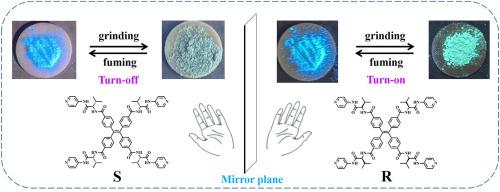具有高对比度特性的机械响应型荧光 AIE 对映体
IF 3.6
3区 物理与天体物理
Q2 OPTICS
引用次数: 0
摘要
本文展示了一对新型手性 AIE 对映体(S-ETMPB 和 R-ETMPB),它们具有完全相反的机械发光活性。R-ETMPB 显示出可逆的开启机械荧光,量子产率(QY)显著增加,而 S-ETMPB 则显示出可逆的关闭机械荧光。值得注意的是,研磨-熏蒸和加热过程可以多次重复,显示出良好的可逆性,没有疲劳迹象。结晶相和无定形相之间的可逆物理变化已被证明是产生不同机械荧光变色行为的原因。此外,两种对映体都具有聚集诱导发射的特性。随着含水量的增加,S-ETMPB 和 R-ETMPB 的荧光量子产率可从 0.56% 到 0.86% 显著上升到 18.89% 和 23.61% 的最大值,从而使 S-ETMPB 和 R-ETMPB 的 AIE 系数分别达到约 33.7 和 27.5。本文章由计算机程序翻译,如有差异,请以英文原文为准。

Mechano-responsive fluorescent AIE enantiomers with high contrast properties
A pair of novel chiral AIE enantiomers (S-ETMPB and R-ETMPB) with entirely opposite mechanoluminescence activities were demonstrated here. R-ETMPB displayed reversible turn-on mechanofluorochromism with a significant increase in quantum yield (QY), whereas S-ETMPB exhibited reversible turn-off mechanofluorochromism. Notably, the processes of grinding-fumigation and heating can be repeated over multiple cycles, demonstrating good reversibility without signs of fatigue. The reversible physical transformation between the crystalline and amorphous phases has been shown to account for the distinct mechanofluorochromic behaviors. Furthermore, both enantiomers possess the characteristic property of aggregation-induced emission. As the water content increases, the fluorescence quantum yields of S-ETMPB and R-ETMPB can significantly rise from 0.56 % to 0.86 % to maximum values of 18.89 % and 23.61 %, resulting in AIE factors of approximately 33.7 for S-ETMPB and 27.5 for R-ETMPB, respectively.
求助全文
通过发布文献求助,成功后即可免费获取论文全文。
去求助
来源期刊

Journal of Luminescence
物理-光学
CiteScore
6.70
自引率
13.90%
发文量
850
审稿时长
3.8 months
期刊介绍:
The purpose of the Journal of Luminescence is to provide a means of communication between scientists in different disciplines who share a common interest in the electronic excited states of molecular, ionic and covalent systems, whether crystalline, amorphous, or liquid.
We invite original papers and reviews on such subjects as: exciton and polariton dynamics, dynamics of localized excited states, energy and charge transport in ordered and disordered systems, radiative and non-radiative recombination, relaxation processes, vibronic interactions in electronic excited states, photochemistry in condensed systems, excited state resonance, double resonance, spin dynamics, selective excitation spectroscopy, hole burning, coherent processes in excited states, (e.g. coherent optical transients, photon echoes, transient gratings), multiphoton processes, optical bistability, photochromism, and new techniques for the study of excited states. This list is not intended to be exhaustive. Papers in the traditional areas of optical spectroscopy (absorption, MCD, luminescence, Raman scattering) are welcome. Papers on applications (phosphors, scintillators, electro- and cathodo-luminescence, radiography, bioimaging, solar energy, energy conversion, etc.) are also welcome if they present results of scientific, rather than only technological interest. However, papers containing purely theoretical results, not related to phenomena in the excited states, as well as papers using luminescence spectroscopy to perform routine analytical chemistry or biochemistry procedures, are outside the scope of the journal. Some exceptions will be possible at the discretion of the editors.
 求助内容:
求助内容: 应助结果提醒方式:
应助结果提醒方式:


